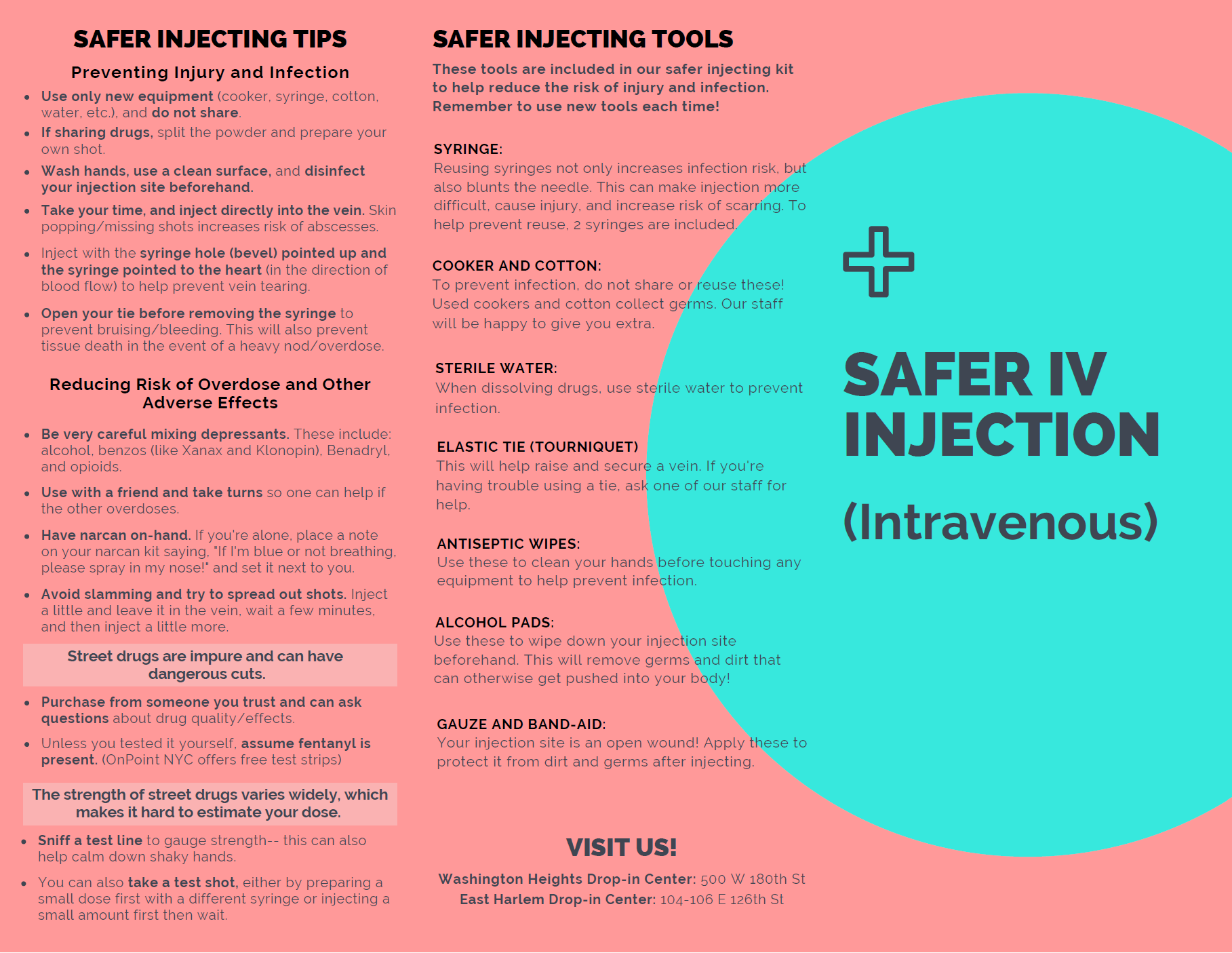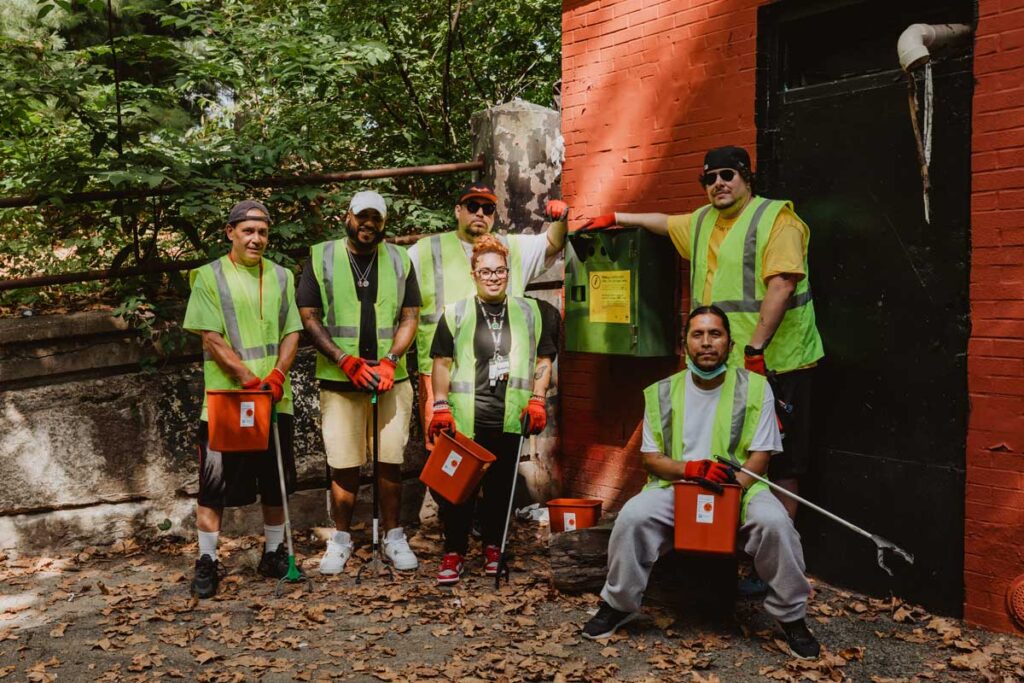
Safer IV (Intraveneous) Injection Guide
A step-by-step guide on IV (Intraveneous) injection, a publication by OnPoint NYC.
SAFER INJECTING TIPS
Preventing Injury and Infection
- Use only new equipment (cooker, syringe, cotton, water, etc.), and do not share.
- If sharing drugs, split the powder and prepare your own shot.
- Wash hands, use a clean surface, and disinfect your injection site beforehand.
- Take your time, and inject directly into the vein. Skin popping/missing shots increases risk of abscesses.
- Inject with the syringe hole (bevel) pointed up and the syringe pointed to the heart (in the direction of blood flow) to help prevent vein tearing.
- Open your tie before removing the syringe to prevent bruising/bleeding. This will also prevent tissue death in the event of a heavy nod/overdose.
Reducing Risk of Overdose and Other Adverse Effects
- Be very careful mixing depressants. These include: alcohol, benzos (like Xanax and Klonopin), Benadryl, and opioids.
- Use with a friend and take turns so one can help if the other overdoses.
- Have narcan on-hand. If you’re alone, place a note on your narcan kit saying, “If I’m blue or not breathing, please spray in my nose!” and set it next to you.
- Avoid slamming and try to spread out shots. Inject a little and leave it in the vein, wait a few minutes, and then inject a little more.
Street drugs are impure and can have dangerous cuts.
- Purchase from someone you trust and can ask questions about drug quality/effects.
- Unless you tested it yourself, assume fentanyl is present. (OnPoint NYC offers free test strips)
The strength of street drugs varies widely, which makes it hard to estimate your dose.
- Sniff a test line to gauge strength– this can also help calm down shaky hands.
- You can also take a test shot, either by preparing a small dose first with a different syringe or injecting a small amount first then wait.
SAFER INJECTING TOOLS
These tools are included in our safer injecting kit to help reduce the risk of injury and infection. Remember to use new tools each time!
SYRINGE:
Reusing syringes not only increases infection risk, but also blunts the needle. This can make injection more difficult, cause injury, and increase risk of scarring. To help prevent reuse, 2 syringes are included.
COOKER AND COTTON:
To prevent infection, do not share or reuse these!Used cookers and cotton collect germs. Our staff will be happy to give you extra.
STERILE WATER: When dissolving drugs, use sterile water to prevent infection.
ELASTIC TIE (TOURNIQUET)
This will help raise and secure a vein. If you’re having trouble using a tie, ask one of our staff for help.
ANTISEPTIC WIPES:
Use these to clean your hands before touching any equipment to help prevent infection.
ALCOHOL PADS:
Use these to wipe down your injection site beforehand. This will remove germs and dirt that can otherwise get pushed into your body!
GAUZE AND BAND-AID: Your injection site is an open wound! Apply these to protect it from dirt and germs after injecting.
STEP-BY-STEP: HOW TO INJECT MORE SAFELY
- Clean hands and surface for preparing shot
Wash your hands with warm water and soap or antiseptic wipes. Place a clean sheet of paper on a flat surface to help prevent contaminating equipment. - Pour powder into a fresh cooker
TIP: If you’re unsure of the strength, pour half of what you normally do. You can always do the rest after! - Add sterile water to cooker
Uncap your fresh syringe and fill no more than half of the barrel with sterile water. Carefully add it to your cooker.
TIP: If you can’t access sterile water, use cold running water or unopened bottled water. - Mix to dissolve powder
Use a syringe cap to mix the liquid until all of the powder is dissolved.
TIP: Do not use the plunger since it will collect unmixed particles, which will end up in your shot and veins! - Add fresh cotton to cooker (to protect needletip)
TIP: Cigarette filters contain harmful chemicals. If you don’t have fresh cotton, use the head of a fresh Q-tip. - Draw mixture from cooker into syringe
Rest needle– with the hole (bevel) pointed down– gently on cotton. Draw mixture into your syringe by pulling back plunger, then carefully set it on your clean surface. - Find a usable vein
It’s easier to find a vein if you’re warm and hydrated. Drink lots of water and try doing push-ups or arm swings.
TIP: Healthy veins feel bouncy. Never inject where there’s a pulse. - Prepare injection site
Use alcohol pads to clean site. Wipe one time in one direction. Don’t scrub. Allow site to dry– avoid touching/blowing on the site since that’ll just make it dirty again! - Use tie to secure vein (few inches above site)
Tie it in a way that allows you to easily open it with one hand or your mouth. Remove tie if you experience throbbing, tingling, or start turning blue.
TIP: Need to make a tie?: Stick to elastic materials (pantyhose, latex gloves, condoms). Stretchy socks and neckties also work. These are safer than belts, shoelaces, and other stiff/thin materials. - Insert syringe and register
Insert needle bevel up in the direction of blood flow (see pictures on top right). Pull plunger back slightly to confirm you’ve hit a vein. Dark red blood should flow easily into the syringe. Stop if you feel a sharp pain or the blood is pink/foamy– this means you’ve hit an artery!
If you hit an artery or don’t see blood: Open tie and remove syringe. Add a bit of cold water to prevent clogging and repeat steps 7-10 using a new site and fresh syringe. DO NOT dig around– this can tear your vein! - Inject into the vein
Unsure you’re in a vein? Pause and register again.
TIP: It’s best to undo your tie before injecting. If not, at least open it before removing the syringe! - Cover the site to prevent infection
Use a fresh Band-Aid– with or without gauze– to cover the injection site. - Safely discard used supplies in sharps container
Throw out all used equipment (syringe, cooker, cotton, used alcohol pads) in a sharps container (available at harm reduction programs and medical facilities).
No sharps container?: Use a puncture resistant container (bleach or detergent bottle). Clearly label, “Contains Sharps.” Do not flush syringes down the toilet since this can damage plumbing and end up on beaches!
Have a Question about Safer Injection?
Email us your drug education questions at [email protected]
Visit Us
Locations
East Harlem
104 -106 E 126th Street
New York, NY 10035
Washington Heights
500 W 180th Street
New York, NY 10033
Email: [email protected]
Phone: (212) 828-8464
Drop-in Centers Hours
Washington Heights DIC
Monday – Friday: 7:30 AM – 11 PM
Weekends: 9 AM – 4:30 PM
East Harlem DIC
Monday – Friday: 7:30 AM – 11PM
Weekends: 10:30 AM – 6 PM
